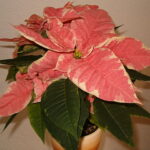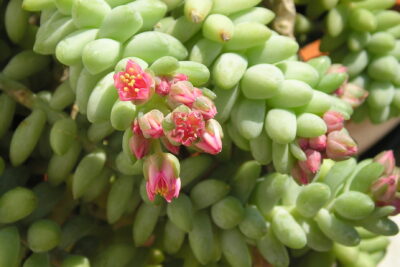
Discover the Stunning Succulent Plants with Rainbow-Colored Leaves

Succulent plants have gained immense popularity in recent years due to their unique and eye-catching appearance. These plants are known for their ability to store water in their leaves, making them highly adaptable to different environments. While succulents come in a wide variety of colors and shapes, one particular type that has been capturing the attention of plant enthusiasts is the succulent plants with rainbow-colored leaves.
We will take a closer look at these stunning succulent plants with rainbow-colored leaves. We will explore the different types of succulents that exhibit this mesmerizing feature, discussing their characteristics and care requirements. Additionally, we will provide tips on how to incorporate these colorful succulents into your indoor and outdoor gardens, showcasing their beauty and versatility. Whether you are a seasoned succulent lover or new to the world of plants, this article will surely inspire you to bring a touch of rainbow into your plant collection.
- Research different varieties of succulent plants with rainbow-colored leaves
- Visit a local plant nursery or garden center to see if they have any succulents with rainbow-colored leaves available
- Check online plant stores or marketplaces that specialize in rare and unique plants
- Join a succulent enthusiasts group or forum to connect with other plant lovers who may have recommendations or be willing to trade cuttings of succulents with rainbow-colored leaves
- Experiment with different growing conditions, such as adjusting light levels or temperature, to enhance the colors of your succulent plants
- Consider using plant dyes or natural colorants to artificially enhance the rainbow colors of your succulent plants.
- Keep your succulent plants healthy and well-cared for to ensure they maintain their vibrant colors
- Share your stunning succulent plants with rainbow-colored leaves on social media or in plant competitions to inspire others and showcase your green thumb
- Frequently Asked Questions
Research different varieties of succulent plants with rainbow-colored leaves
If you're a plant enthusiast or simply looking to add some vibrant colors to your garden or indoor space, succulent plants with rainbow-colored leaves are a must-have. These stunning plants are sure to catch your eye and bring a unique touch to any setting.
Why choose succulent plants with rainbow-colored leaves?
Succulent plants are known for their ability to store water in their leaves, making them highly adaptable to various climates and environments. But what sets the rainbow-colored varieties apart is their extraordinary pigmentation, which creates a mesmerizing display of colors.
These plants come in a wide range of shapes, sizes, and color combinations, making them incredibly versatile for any design or aesthetic preference. From bold and vibrant hues to soft pastels and variegated patterns, there's a succulent with rainbow-colored leaves to suit every taste.
Popular varieties of succulent plants with rainbow-colored leaves
1. Echeveria 'Rainbow Burst': This variety features rosettes with a beautiful blend of pink, purple, and green tones. Its compact size makes it ideal for small pots or arrangements.
 Exploring the Diversity: Succulents in Mixed Genus Categories
Exploring the Diversity: Succulents in Mixed Genus Categories2. Aeonium 'Kiwi': The 'Kiwi' succulent showcases a mix of green, pink, and creamy yellow leaves, creating a striking contrast. Its branching habit adds an interesting dimension to any space.
3. Crassula 'Campfire': With its fiery red and orange foliage, the 'Campfire' succulent is reminiscent of a blazing bonfire. Its compact growth habit makes it perfect for both indoor and outdoor settings.
4. Sedum 'Firestorm': True to its name, this sedum variety boasts intense red and orange hues that resemble flames. It's a low-maintenance plant that thrives in full sun and well-draining soil.
- Tip: When selecting succulents with rainbow-colored leaves, consider their lighting requirements and growth habits to ensure they thrive in your specific environment.
- Caution: While these succulents are visually stunning, some varieties may require more care and attention than others. Be sure to research each plant's specific needs before bringing them home.
Whether you're a seasoned succulent collector or a beginner looking to add a pop of color to your space, incorporating succulent plants with rainbow-colored leaves is a fantastic way to elevate your plant game. These unique plants will undoubtedly become the focal point of any garden or interior design.
Visit a local plant nursery or garden center to see if they have any succulents with rainbow-colored leaves available
If you are a fan of unique and vibrant plants, then you must explore the world of succulents with rainbow-colored leaves. These stunning plants are a true treat for the eyes and can add a pop of color to any space.
One of the best ways to discover these beautiful succulents is by visiting a local plant nursery or garden center. Here, you can explore a wide variety of plants and see if they have any succulents with rainbow-colored leaves available. The knowledgeable staff can guide you and provide valuable information about these plants.
Before you go:
 Exploring the Possibility: Can Succulents Really Have Black Flowers?
Exploring the Possibility: Can Succulents Really Have Black Flowers?- Research about the different types of succulents that have rainbow-colored leaves.
- Make a list of the specific varieties you are interested in.
- Check the operating hours and availability of the nursery or garden center.
Once you arrive at the nursery or garden center, take your time to browse through the different sections and look for the succulents you are interested in. Keep an eye out for plants with leaves displaying vibrant shades of red, orange, yellow, green, blue, and purple.
Things to consider:
- Inspect the overall health and condition of the plant.
- Check for any signs of pests or diseases.
- Ask the staff about the care requirements of the succulent.
Remember, succulents with rainbow-colored leaves require specific care to maintain their vibrant colors. It is important to understand their sunlight, watering, and soil requirements to ensure their longevity.
Once you have selected your favorite succulent with rainbow-colored leaves, don't forget to ask the staff for any additional care tips or recommendations. They may provide valuable insights that can help you successfully care for your new plant.
Bringing home a succulent with rainbow-colored leaves will not only enhance the aesthetics of your space but also provide you with a unique and captivating plant to care for. So, embark on your journey to discover these stunning succulents and enjoy the beauty they bring into your life.
Check online plant stores or marketplaces that specialize in rare and unique plants
If you're looking to add some vibrancy and uniqueness to your plant collection, you'll be delighted to discover the stunning succulent plants with rainbow-colored leaves. These remarkable plants are real showstoppers and are sure to become the center of attention in any room or garden.
To get your hands on these extraordinary succulents, you can start by checking online plant stores or marketplaces that specialize in rare and unique plants. These platforms often have a wide variety of succulents available, including those with rainbow-colored leaves.
 Unveiling the Leafy Secrets of Succulents: Exploring Their Diversity
Unveiling the Leafy Secrets of Succulents: Exploring Their DiversityWhen browsing through these online stores, be sure to read the descriptions and check the photos of the plants carefully. Look for keywords like "rainbow," "multicolored," or "variegated" to find the succulents you're interested in. Additionally, pay attention to the size and care requirements of each plant to ensure it will thrive in your specific environment.
Some popular online plant stores to consider include:
- Plantify - This online store offers a diverse selection of succulents, including many with rainbow-colored leaves. They provide detailed descriptions and care instructions for each plant, making it easier for you to choose the perfect one for your collection.
- Succulent City - Known for their wide range of succulents, Succulent City also offers a variety of rainbow-colored succulents. They provide excellent customer service and ensure that each plant is carefully packaged to arrive in optimal condition.
- The Succulent Source - With a focus on high-quality succulents, The Succulent Source is another great option for finding succulents with rainbow-colored leaves. They offer a variety of sizes and shapes, allowing you to select the ones that best suit your preferences.
Once you've found the online store that suits your needs, simply add the desired succulents to your cart and proceed with the checkout process. Most online plant stores offer secure payment options and provide shipping services to deliver the plants directly to your doorstep.
Remember to be patient, as some rare succulents may have limited availability or may need to be pre-ordered. However, the wait will be worth it when you finally receive your stunning succulent plants with rainbow-colored leaves.
Join a succulent enthusiasts group or forum to connect with other plant lovers who may have recommendations or be willing to trade cuttings of succulents with rainbow-colored leaves
If you are a plant lover and have a passion for succulents, joining a succulent enthusiasts group or forum is a fantastic way to connect with like-minded individuals who share your love for these stunning plants. These communities are filled with knowledgeable and experienced succulent enthusiasts who can provide valuable insights and recommendations.
One of the benefits of joining a succulent enthusiasts group or forum is the opportunity to discover and learn about succulents with rainbow-colored leaves. These unique and vibrant plants are sure to add a touch of magic to any collection.
Trade Cuttings
Once you've joined a succulent enthusiasts group or forum, you may find that fellow members are willing to trade cuttings of succulents with rainbow-colored leaves. This can be an exciting and cost-effective way to expand your collection and acquire some truly beautiful plants.
 Best Low-Light Cactus & Succulents for Indoor Spaces
Best Low-Light Cactus & Succulents for Indoor SpacesTrading cuttings with other members not only allows you to obtain new and rare varieties of succulents but also provides an opportunity to connect with other plant lovers and share your own knowledge and experiences.
Recommendations from Fellow Enthusiasts
Being part of a succulent enthusiasts group or forum enables you to tap into a vast pool of knowledge and expertise. Many members are likely to have experience growing succulents with rainbow-colored leaves and can offer valuable recommendations based on their personal experiences.
Whether you are looking for specific species or simply seeking advice on care and maintenance, fellow enthusiasts can provide valuable insights and tips to help you successfully grow and enjoy your rainbow-colored succulents.
Stay Updated on New Releases
By actively participating in a succulent enthusiasts group or forum, you can stay updated on the latest releases of succulents with rainbow-colored leaves. Members often share information about new cultivars or hybrid varieties that are hitting the market.
This allows you to be among the first to discover and acquire these stunning plants, adding them to your collection before they become widely available. It's a great way to stay ahead of trends in the succulent world and showcase unique and eye-catching plants.
Joining a succulent enthusiasts group or forum is a fantastic way to connect with other plant lovers and explore the world of succulents with rainbow-colored leaves. By trading cuttings, seeking recommendations, and staying updated on new releases, you can enhance your collection and create a stunning display of these vibrant and mesmerizing plants.
Experiment with different growing conditions, such as adjusting light levels or temperature, to enhance the colors of your succulent plants
 Exploring Succulents: Discovering Flower-Like Varieties
Exploring Succulents: Discovering Flower-Like VarietiesAdding a pop of color to your garden or indoor space has never been easier with the stunning succulent plants that boast rainbow-colored leaves. These unique plants are sure to add a touch of vibrancy and beauty to any setting. With their wide range of colors, from deep purples and blues to bright pinks and yellows, succulents with rainbow-colored leaves are a true sight to behold.
If you're looking to make your succulent collection stand out even more, you can experiment with different growing conditions to enhance the colors of these beautiful plants. One way to do this is by adjusting the light levels. While succulents generally thrive in bright light, some varieties may benefit from a bit of shade to intensify their colors. Try placing them in a location where they receive indirect sunlight or use a sheer curtain to filter the light.
Temperature is another factor that can influence the coloration of succulent leaves. Some succulents, like Echeverias, develop deeper hues when exposed to cooler temperatures. If you live in a region with mild winters, consider moving your succulents outdoors during the colder months to encourage more vibrant colors. Just be sure to provide them with some protection from frost and extreme weather conditions.
When it comes to watering, it's important to strike the right balance. Overwatering can lead to root rot and dull the colors of succulent leaves, while underwatering can cause the leaves to lose their brilliance. Find a watering routine that works for your specific succulent varieties, ensuring that the soil is completely dry between waterings.
Lastly, don't underestimate the power of proper nutrition. Providing your succulents with a balanced fertilizer during their active growing season can help enhance their leaf coloration. Look for a fertilizer specifically formulated for succulents and follow the instructions on the packaging for best results.
If you're seeking a way to inject some color into your garden or indoor space, look no further than succulent plants with rainbow-colored leaves. With a little experimentation and careful attention to their growing conditions, you can unlock the full potential of these stunning plants and enjoy their vibrant hues year-round.
Consider using plant dyes or natural colorants to artificially enhance the rainbow colors of your succulent plants.
Adding a touch of vibrant color to your succulent garden can be a delightful way to showcase the beauty of these stunning plants. While succulents are known for their unique shapes and textures, some varieties also have the ability to display a mesmerizing array of rainbow-colored leaves.
A Guide to the Most Common Types of Succulents and Care TipsIf you want to take your succulent garden to the next level and create a truly awe-inspiring display, consider using plant dyes or natural colorants to enhance the vibrant hues of your plants. By artificially enhancing the rainbow colors of your succulents, you can create a magical and eye-catching garden that will surely turn heads.
Plant Dyes for Rainbow-Colored Succulents
Plant dyes are an excellent option for adding intense and long-lasting colors to your succulent plants. These dyes are specially formulated to provide vibrant pigments that can be absorbed by the plants, resulting in stunning rainbow-colored leaves.
When using plant dyes, it's essential to choose high-quality products that are safe for your succulents. Look for dyes specifically made for plants, as they are designed to be non-toxic and won't harm your plants.
Before applying the dye, make sure your succulents are healthy and well-watered. This will ensure that the dye is absorbed evenly throughout the plant. It's advisable to wear gloves to protect your hands from staining, as some dyes can be quite potent.
- Step 1: Dilute the plant dye according to the instructions on the packaging.
- Step 2: Gently remove your succulent from its pot, being careful not to damage the roots.
- Step 3: Dip a clean paintbrush or sponge into the diluted dye and apply it evenly to the leaves of your succulent.
- Step 4: Allow the dye to dry completely before placing your succulent back in its pot.
- Step 5: Regularly water and care for your succulent as usual, ensuring it receives adequate sunlight and proper drainage.
With proper care, your rainbow-colored succulents will continue to display their vibrant hues for an extended period, adding a touch of whimsy and beauty to your garden.
Natural Colorants for Rainbow-Colored Succulents
If you prefer a more natural approach, you can experiment with various plant-based colorants to achieve rainbow colors on your succulents. These colorants can be derived from fruits, vegetables, or even flowers, providing a more organic and eco-friendly alternative.
Creating your own natural colorants is a fun and creative process. Here are some examples of natural colorants you can try:
 Dormant Succulents: Which Varieties Hibernate in Winter?
Dormant Succulents: Which Varieties Hibernate in Winter?- Beetroot Juice: Boil beetroot slices in water and strain the liquid. Use this vibrant red liquid to dye your succulent leaves.
- Blueberry Juice: Crush fresh blueberries and strain the juice. Apply the deep purple liquid to your succulents for a stunning color transformation.
- Turmeric Paste: Mix turmeric powder with water to create a thick paste. Apply the paste to your succulents for a vibrant yellow hue.
- Hibiscus Tea: Brew hibiscus tea and let it cool. Use the bright red liquid to create a colorful effect on your succulent leaves.
Remember to dilute the natural colorants with water to achieve the desired intensity and test a small portion of your succulent first to ensure it doesn't have any adverse reactions.
Whether you choose plant dyes or natural colorants, experimenting with rainbow-colored succulents can be a rewarding and creative endeavor. So go ahead and unleash your imagination to create a stunning succulent garden that will leave everyone in awe!
Keep your succulent plants healthy and well-cared for to ensure they maintain their vibrant colors
Succulent plants are known for their unique and eye-catching appearance, but did you know that some succulents have leaves that come in a stunning array of rainbow colors? These vibrant plants can instantly add a pop of color to any indoor or outdoor space, making them a favorite among plant enthusiasts.
To keep your succulent plants looking their best and to preserve their rainbow-colored leaves, it's important to provide them with the proper care and attention. Here are a few tips to help you maintain the health and vibrancy of your succulent collection:
1. Provide Adequate Sunlight
Succulents thrive in bright, indirect sunlight. Place your rainbow-colored succulents near a sunny window or in a well-lit area where they can receive at least 6 hours of sunlight per day. However, be cautious not to expose them to direct sunlight for extended periods, as this can cause sunburn and damage the leaves.
 Diverse Native Succulents of Southern California
Diverse Native Succulents of Southern California2. Water Sparingly
Succulents are drought-tolerant plants that store water in their leaves and stems. Overwatering can lead to root rot and the loss of vibrant colors. Allow the soil to dry out completely between waterings, and ensure that the pot has proper drainage to prevent waterlogged roots.
3. Use Well-Draining Soil
Succulents require well-draining soil to prevent water retention, which can lead to root rot. Use a sandy or gritty soil mix specifically formulated for succulents and cacti. This type of soil will allow excess water to drain away quickly, keeping the roots healthy and preventing water-related issues.
4. Maintain Proper Temperature
Most succulent plants thrive in temperatures between 60°F and 80°F (15°C to 26°C). Avoid exposing them to extreme cold or hot temperatures, as this can cause stress and damage the leaves. Keep them in an environment with stable temperatures and protect them from drafts or sudden temperature changes.
5. Avoid Overfertilizing
 Discover the Diverse Range of Shapes and Colors in Succulent Varieties
Discover the Diverse Range of Shapes and Colors in Succulent VarietiesWhile succulents do benefit from occasional fertilization, it's important not to overdo it. Use a balanced, low-nitrogen fertilizer specifically designed for succulents, and follow the recommended dosage instructions. Overfertilizing can lead to excessive growth, weak leaves, and a loss of vibrant colors.
6. Regularly Remove Dead Leaves
As succulent plants grow, older leaves may naturally die off. It's important to remove these dead leaves promptly to prevent them from attracting pests or causing diseases. Gently pluck or trim off any brown or withered leaves to keep your succulent looking healthy and vibrant.
By following these care tips, you can ensure that your rainbow-colored succulent plants remain healthy and continue to display their stunning array of colors. Remember, proper sunlight, watering, soil, temperature, fertilization, and maintenance are key to maintaining the vibrant beauty of these unique plants.
If you're a plant lover and enjoy adding a touch of vibrant color to your collection, look no further than stunning succulent plants with rainbow-colored leaves. These unique and eye-catching plants are a must-have for any green thumb enthusiast.
Whether you're a seasoned plant collector or just starting your botanical journey, these succulents will undoubtedly captivate your attention. With their mesmerizing hues and intricate patterns, they bring a pop of color and a touch of magic to any space.
Why Choose Succulent Plants with Rainbow-Colored Leaves?
Succulents with rainbow-colored leaves are not only visually appealing but also come with numerous benefits. Here are a few reasons why these plants should be on your radar:
 Vibrant Green and Red Succulents: Perfect for Your Garden
Vibrant Green and Red Succulents: Perfect for Your Garden- Unique Aesthetic: The striking colors and patterns of these succulents make them stand out among other plants. Their rainbow leaves create a beautiful contrast against the typical green foliage, adding an instant wow factor to your collection.
- Low Maintenance: Like other succulents, plants with rainbow-colored leaves are known for their ability to thrive in arid conditions. They require minimal watering and can tolerate drought, making them an ideal choice for busy individuals or those new to plant care.
- Versatility: These succulents are available in a wide variety of shapes, sizes, and colors. Whether you prefer small potted plants for your windowsill or larger specimens as centerpiece displays, there's a rainbow-colored succulent to suit every preference and space.
- Indoor and Outdoor Options: Depending on the specific succulent you choose, they can thrive both indoors and outdoors. This versatility allows you to enjoy their stunning colors and unique foliage no matter the location.
Popular Succulent Varieties with Rainbow-Colored Leaves
Ready to add some rainbow magic to your plant collection? Here are a few popular succulent varieties that boast stunning rainbow-colored leaves:
- Echeveria 'Rainbow': With its rosette-shaped foliage and hues of pink, purple, blue, and green, this succulent is a true showstopper.
- Aeonium 'Kiwi': Known for its variegated leaves in shades of green, cream, and pink, this succulent adds a touch of elegance to any arrangement.
- Graptopetalum paraguayense 'Ghost Plant': This ghostly succulent features pastel blue-gray leaves that take on a beautiful pinkish hue when exposed to sunlight.
- Kalanchoe 'Fantastic': With its scalloped leaves in shades of pink, purple, and green, this succulent adds a whimsical touch to any space.
These are just a few examples of the many stunning succulent plants with rainbow-colored leaves available. Explore your local nurseries, online plant shops, and plant communities to discover even more varieties that will leave you in awe.
Remember, the beauty of these succulents lies not only in their vibrant colors but also in the joy they bring to your plant collection. Share your stunning rainbow succulents on social media or participate in plant competitions to inspire others and showcase your green thumb. Happy gardening!
Frequently Asked Questions
1. What are succulent plants?
Succulent plants are plants that have thick, fleshy leaves and stems that store water, allowing them to survive in arid conditions.
2. Do all succulent plants have rainbow-colored leaves?
No, not all succulent plants have rainbow-colored leaves. While some succulents do have vibrant and colorful foliage, others have more muted or monochromatic colors.
3. How do succulents get their rainbow-colored leaves?
Succulents get their rainbow-colored leaves from pigments called anthocyanins, which are responsible for producing shades of red, purple, and blue in the leaves.
4. Can I grow succulents with rainbow-colored leaves indoors?
Yes, you can grow succulents with rainbow-colored leaves indoors. However, it is important to provide them with adequate sunlight or artificial grow lights to maintain their vibrant colors.
If you want to read more articles similar to Discover the Stunning Succulent Plants with Rainbow-Colored Leaves, you can visit the Varieties and Colors category.






You Must Read